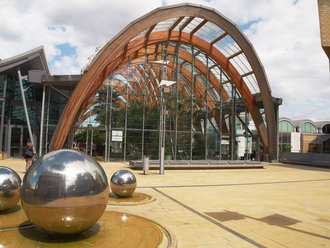Olympus M.Zuiko Digital ED 14-42mm f/3.5-5.6 Lens
Olympus M.Zuiko Digital ED 14-42mm f/3.5-5.6 MkI: Performance
This lens produces images with excellent sharpness across the frame from maximum aperture at 14mm, and its performance seems to be limited only by diffraction. At this focal length peak quality across the frame is achieved at f/4, where sharpness is excellent from corner to corner.Zooming to 25mm results in similar excellent sharpness across the frame at maximum aperture, which is where peak performance is also found.
Finally at 42mm, sharpness in the centre of the frame is outstanding, but the sharpness towards the edges of the frame has dropped to good levels. Stopping down to f/8 improves sharpness across the frame so that the clarity towards the edges is very good.
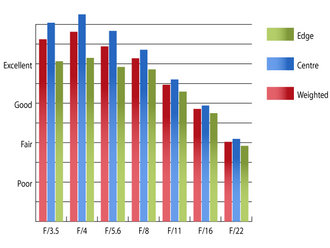 MTF at 14mm | 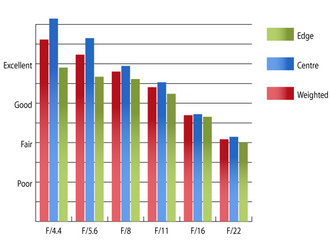 MTF at 25mm | |
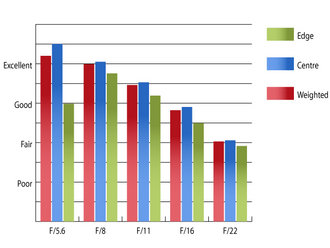 MTF at 42mm | How to read our chartsThe blue column represents readings from the centre of the picture frame at the various apertures and the green is from the edges. Averaging them out gives the red weighted column.The scale on the left side is an indication of actual image resolution. The taller the column, the better the lens performance. Simple. For this review, the lens was tested on an Olympus PEN E-PL1 using Imatest. |
Imatest recorded some of the lowest levels of chromatic aberrations I've seen so far. At their worst they just about reach half a pixel width at f/22 and 14mm.
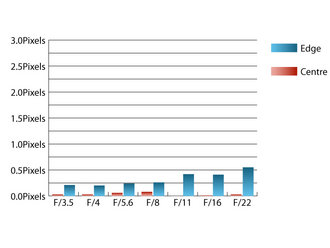 CA at 14mm | 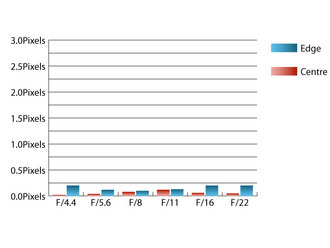 CA at 25mm | |
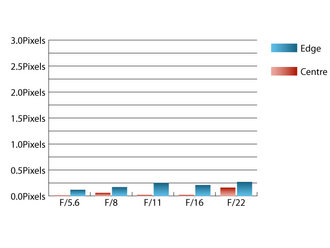 CA at 42mm | How to read our chartsChromatic aberration is the lens' inability to focus on the sensor or film all colours of visible light at the same point. Severe chromatic aberration gives a noticeable fringing or a halo effect around sharp edges within the picture. It can be cured in software.Apochromatic lenses have special lens elements (aspheric, extra-low dispersion etc) to minimize the problem, hence they usually cost more. For this review, the lens was tested on an Olympus PEN E-PL1 using Imatest. |
Falloff of illumination towards the corners of the image area is well controlled. Throughout the zoom range the corners are only 0.4 stops darker than the image centre at maximum aperture and illumination is visually uniform when the lens is stopped down just one stop.
Olympus Micro Four Thirds compatible cameras automatically correct distortion in camera, so the following won't be noticeable if shooting JPEG images, or if the software supplied with the camera is used to convert the RAW images. At 14mm distortion is quite pronounced with Imatest detecting 6.55% barrelling and at 42mm this is replaced by 2.29% pincushion distortion, which is a reasonably high level. Luckily the distortion pattern is uniform across the frame, so it should be easy enough to correct in image editing software afterwards.
Although the lens isn't supplied with a hood, it is very resistant to flare and loss of contrast. Shooting directly into strong light sources may cause a slight loss of contrast in extreme instances, especially at 42mm and flare may be caused by very strong light sources just outside the frame.
Add your message
Login required
Please login here or if you've not registered, you can register here. Registering is safe, quick and free.
Please login here or if you've not registered, you can register here. Registering is safe, quick and free.
photodo Stats
1102 lenses
428 MTF tests
74 in-depth photodo reviews
100+ users join each day
Help the lens community by reviewing or rating a lens today via our lens search
428 MTF tests
74 in-depth photodo reviews
100+ users join each day
Help the lens community by reviewing or rating a lens today via our lens search
Latest Lens Reviews
- Chinon 28mm f/2.8 Vintage Lens Review
- Canon EF 70-200mm f/4L IS II USM Lens Review
- Samyang AF 85mm f/1.4 EF Review
- Sigma 70mm f/2.8 DG Macro Art Review
- Samyang AF 24mm f/2.8 FE Review
- Meike 50mm f/1.7 Review
- Tamron 70-210mm f/4 Di VC USD Review
- Lensbaby Burnside 35mm f/2.8 Review
- Asahi Super Takumar 50mm f/1.4 Review
- Asahi Super-Multi-Coated Takumar 135mm f/3.5 Review




